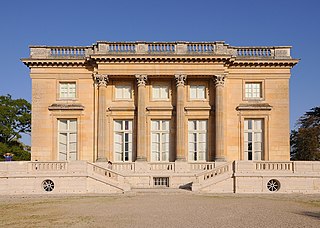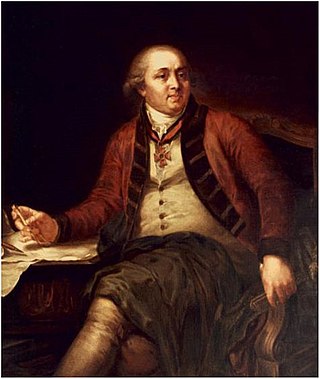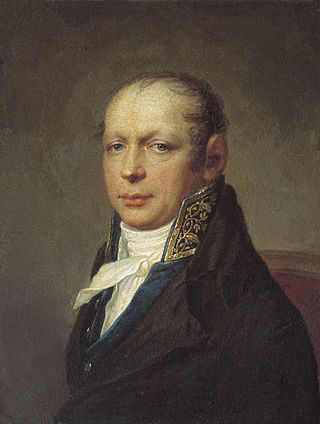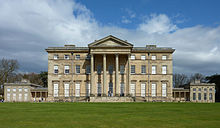
Baroque architecture is a highly decorative and theatrical style which appeared in Italy in the early 17th century and gradually spread across Europe. It was originally introduced by the Catholic Church, particularly by the Jesuits, as a means to combat the Reformation and the Protestant church with a new architecture that inspired surprise and awe. It reached its peak in the High Baroque (1625–1675), when it was used in churches and palaces in Italy, Spain, Portugal, France, Bavaria and Austria. In the Late Baroque period (1675–1750), it reached as far as Russia, the Ottoman Empire and the Spanish and Portuguese colonies in Latin America. In about 1730, an even more elaborately decorative variant called Rococo appeared and flourished in Central Europe.
The year 1814 in architecture involved some significant events.
The year 1789 in architecture involved some significant events.

Neoclassical architecture, sometimes referred to as Classical Revival architecture, is an architectural style produced by the Neoclassical movement that began in the mid-18th century in Italy, France and Germany. It became one of the most prominent architectural styles in the Western world. The prevailing styles of architecture in most of Europe for the previous two centuries, Renaissance architecture and Baroque architecture, already represented partial revivals of the Classical architecture of ancient Rome and ancient Greek architecture, but the Neoclassical movement aimed to strip away the excesses of Late Baroque and return to a purer, more complete, and more authentic classical style, adapted to modern purposes.
The year 1778 in architecture involved some significant events.

Vasily Ivanovich Bazhenov was a Russian neoclassical architect, graphic artist, architectural theorist and educator. Bazhenov and his associates Matvey Kazakov and Ivan Starov were the leading local architects of the Russian Enlightenment, a period dominated by foreign architects. According to Dmitry Shvidkovsky, in the 1770s Bazhenov became the first Russian architect to create a national architectural language since the 17th century tradition interrupted by Peter I of Russia.

Ivan Yegorovich Starov was a Russian architect from St. Petersburg who devised the master plans for Yaroslavl, Voronezh, Pskov, Dnipro, Mykolaiv, and many other towns in Russia and Ukraine. His radial urban master plan for Yaroslavl (1778), cleverly highlighting dozens historic churches and towers, is recognized as one of the World Heritage Sites.

The Ascension Cathedral in the town of Sophia in the vicinity of Saint Petersburg, was one of the first purely Palladian churches to be built in Russia. Rather paradoxically, it may also be defined as "the first example of Byzantinism in Russian architecture".

Pella Palace was a summer residence built during the reign of Catherine II of Russia for her grandson, future emperor Alexander. It was situated on the left bank of the Neva River, 30 km east of Saint Petersburg, where the town of Otradnoye now stands. If completed, it would have been Russia's largest imperial palace. Pella, partially built in 1785-1789, has been razed to the ground by Catherine's son, Paul I of Russia. Not only the buildings disappeared, but very few images of it survived the Battle of the Palaces: existing knowledge of Pella relies on a few facade elevations and watercolors by Giacomo Quarenghi and an elaborate drawing on Catherine's fan, also based on Quarenghi's drafts.

Vincenzo Brenna was an Italian architect and painter who was the house architect of Paul I of Russia. Brenna was hired by Paul and his spouse Maria Fyodorovna as interior decorator in 1781 and by the end of 1780s became the couple's leading architect. Brenna worked on Pavlovsk Palace and Gatchina palaces, rebuilt Saint Isaac's Cathedral, and most notably created Saint Michael's Castle in Saint Petersburg. Most of his architectural works were created concurrently during Paul's brief reign. Soon after Paul was murdered in a palace coup Brenna, renowned for fraud and embezzlement barely tolerated by his late patron, retired and left Russia for an uneventful life in Saxony.

Andreyan Zakharov was a Russian architect and representative of the Empire style. His designs also alternated neoclassicism with eclecticism.
The appearance of Saint Petersburg includes long, straight boulevards, vast spaces, gardens and parks, decorative wrought-iron fences, monuments and decorative sculptures. The Neva River itself, together with its many canals and their granite embankments and bridges help to give the city its particular ambience.
Jean-Baptiste Michel Vallin de la Mothe was a French architect whose major career was spent in St. Petersburg, where he became court architect to Catherine II. His students were Ivan Starov and Vasily Bazhenov.

The "Battle of the Palaces" occurred in the Russian Empire in the last decade of the reign of Catherine II (1784–1796) and the reign of Paul I (1796–1801), with ripple effects extending into the beginning of the reign of Alexander I. A bitter standoff between Catherine and Paul, her only legitimate son and heir, manifested itself in transient political and ideological conflicts, but also had a lasting, tangible impact on Russian architecture. Both parties materialized their political statements and their understanding of sovereign power in expensive construction projects involving the most illustrious architects of the period – Vasily Bazhenov, Vincenzo Brenna, Charles Cameron, Matvey Kazakov, Giacomo Quarenghi, and Ivan Starov. Catherine's palace projects followed the neoclassical canon of the Age of Enlightenment, while Paul deliberately leaned to emerging Romanticism. Buildings that stylistically fell apart from these programs were demolished or rebuilt without hesitation. The "battle" began in 1785 with the demolition of the main palace in Tsaritsyno, and culminated in 1796 with the demolition of Pella, the largest imperial palace in the Saint Petersburg area.

Jean-François Thomas de Thomon was a French neoclassical architect who worked in Eastern Europe in 1791–1813. Thomas de Thomon was responsible for the design of Old Saint Petersburg Stock Exchange and Rostral Columns on the spit of Vasilievsky Island in Saint Petersburg and the first building of the Odessa Theatre, destroyed by fire in 1873. Thomas de Thomon, graduate of the French Academy in Rome, "imported" the high classicism practiced by this school in 1780s into Russia and thus contributed to the formation of Russian national variant of neoclassicism practiced during the reign of Alexander I.

Savva Ivanovich Chevakinsky was a Russian architect of the Baroque school. He worked in Saint Petersburg and Tsarskoye Selo.

Neoclassical architecture in Russia developed in the second half of the 18th century, especially after Catherine the Great succeeded to the throne on June 28, 1762, becoming Empress of Russia. Neoclassical architecture developed in many Russian cities, first of all St. Petersburg, which was undergoing its transformation into a modern capital throughout the reign of Catherine II.

Elizabethan Baroque is a term for the Russian Baroque architectural style, developed during the reign of Elizabeth of Russia between 1741 and 1762. It is also called style Rocaille or Rococo style. The Italian architect Francesco Bartolomeo Rastrelli is the key figure of this trend, which is still given the name 'Rastrellian Baroque'. The Russian architect Savva Chevakinsky is also a renowned figure representing this style.

The Holy Trinity Cathedral of the Alexander Nevsky Lavra is a Russian Orthodox cathedral in Saint Petersburg. It is in the Diocese of Saint Petersburg and part of the Alexander Nevsky Lavra, where it is the cathedral church of the monastery complex.














